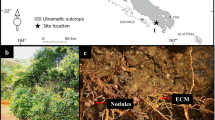Abstract
Twelve herbaceous and shrub legume species were grown in pot and field experiments in five sites representing three agroecological zones in moist savanna in Nigeria. The objectives were to: (1) assess natural nodulation of the legumes and characterize their indigenous rhizobia, (2) determine their need for rhizobia inoculation and (3) estimate the amount of N2 fixed by each of these legumes. At 4 weeks after planting (WAP), Crotolaria verrucosa was not nodulated at any of the sites while Centrosema pascuorum had the highest number of nodules in all sites. At 8 WAP, all legumes were nodulated, with Mucuna pruriens having the least number of nodules and Stylosanthes hamata the highest. The number of nodules, however, was inversely correlated to the mass of nodules. Significant differences in nodulation of the legume species grown in the field also occurred between and within sites. Mucuna pruriens and Lablab purpureus produced more shoot and nodule biomass than the other legumes in all sites. Growth of most of these legumes responded to fertilizer application, except for C. verrucosa and Aeschynomene histrix. Except for C. verrucosa, average proportion of N2 fixed was about 80% and this was reduced by about 20% with N fertilizer application. The majority of rhizobia isolates (60%) were slow growing, belonging to the Bradyrhizobia spp. group. Selected rhizobia isolates evaluated on Cajanus cajan, C. pascuorum, M. pruriens and Psophocarpus palustris varied from ineffective to highly effective in Leonard jar conditions. However, only growth of M. pruriens responded to inoculation in potted soils, whereas it was lower than that obtained with N fertilizer application. This indicated the need to screen more rhizobia in order to improve N2 fixation and growth of legume species such as M. pruriens when it is introduced in soils deficient in N.
Similar content being viewed by others
References
Bushby HVA, Date RA, Sundram J (1986) Rhizobium collections and their assessments. In: Blair GJ, Ivory DA, Evans TR (eds) Forages in Southeast Asian and south Pacific Agriculture. ACIAR, Canberra, pp 133–140
Cadisch G, Sylvester-Bradley R, Nösberger J (1989) 15N based estimates of nitrogen fixation by eight tropical forage-legumes at two levels of P:K supply. Field Crops Res 22:181–208
CIAT (1990) Annual Report. Tropical pastures. Working Document no. 70. CIAT, Cali Colombia
Date RA (1977) Inoculation of tropical pasture legumes. In: Vincent JM, Whitney AS, Bose J (eds) Exploiting the legume-rhizobium symbiosis in tropical agriculture. University of Hawaii College of Tropical Agriculture Special Publication no. 145, pp 293–311
Dreyfus BL, Dommergues YR (1981) Nodulation of Acacia species by fast and slow growing tropical strains of Rhizobium. Appl Environ Microbiol 41:97–99
Giller KE, Wilson KJ (1991) Nitrogen fixation in tropical cropping systems. CAB International, Wallingford UK, p 313
Halliday J (1984) Principles of Rhizobium strain selection. In: Alexander (ed) Biological nitrogen fixation. Plenum, New York, pp 155–171
International Institute of Tropical Agriculture (1989) Analytical manual. IITA, Ibadan, Nigeria
Lal R (1989) Agroforestry systems and soil surface management of a tropical alfisol. Agrofor Syst 8:7–29
Sanginga N, Ibewiro B, Houngnandan P, Vanlauwe B, Okogun JA, Akobundu IO, Versteeg M (1996) Evaluation of symbiotic properties and nitrogen contribution of mucuna to maize grown in the derived savanna of West Africa. Plant and Soil 179:119–129
Sanginga N, Mulongoy K, Ayanaba A (1989) Effectivity of indigenous rhizobia for nodulation and early fixation with Leucaena leucocephala grown in Nigeria Soils. Soil Biol Biochem 21:231–235
Sylvester-Bradley R (1984) Rhizobium inoculation trials designed to support a tropical forage selection programme. Plant and Soil 82:377–386
Sylvester-Bradley R, Souts SM, Date RA (1990) Rhizosphere biology and nitrogen fixation of Centrosema. In: Schultze-Kraft R, Clements RJ (eds) Centrosema — biology, agronomy and utilization. CIAT, Cali, Colombia, pp 151–174
Trinick MJ (1980) Relationships amongst the fast growing rhizobia of Lablab purpureus, Leucaena leucocephaola, Mimosa spp., Acacia farnesiana, Sesbania gradinflora and their affinities with other rhizobia groups. J Bacteriol 49:39–53
Van Keulen H, Van Heemst HDJ (1982) Crop response to the supply of macronutrients. Agric Res Rep 916 (Versl Landbk Onderz), Pudoc, Wageningen, The Netherlands
Vincent JM (1970) A manual for the practical study of root-nodule bacteria. IBP Handbook no. 15, Blackwell, Oxford
Weaver RW, Frederick LR (1972) A new technique for most probable-number counts of rhizobia. Plant and Soil 36:219–222
Author information
Authors and Affiliations
Rights and permissions
About this article
Cite this article
Sanginga, N., Okogun, A., Akobundu, I.O. et al. Nodulation and estimation of symbiotic nitrogen fixation by herbaceous and shrub legumes in Guinea savanna in Nigeria. Biol Fertil Soils 23, 441–448 (1996). https://doi.org/10.1007/BF00335920
Received:
Issue Date:
DOI: https://doi.org/10.1007/BF00335920




